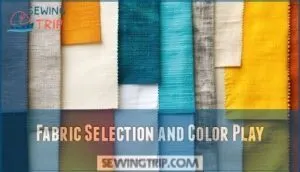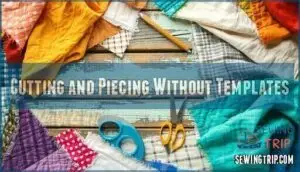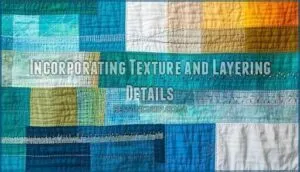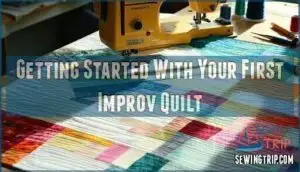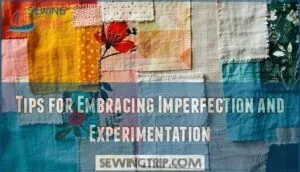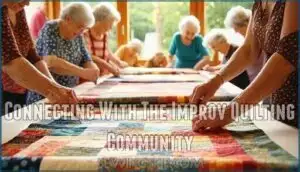This site is supported by our readers. We may earn a commission, at no cost to you, if you purchase through links.
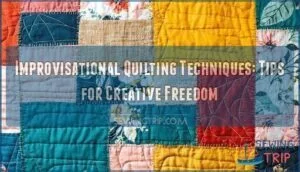
Instead of following predetermined patterns, you’re building a visual language from instinct, letting each piece inform the next. This approach transforms scraps and supposed mistakes into compositions that rigid templates can’t touch. The shift from precision to play unlocks designs that feel alive, asymmetrical, and unmistakably yours.
Table Of Contents
Key Takeaways
- Improvisational quilting replaces rigid patterns with instinct-driven design, where spontaneous cutting, piecing, and color choices create asymmetrical compositions that feel authentically personal rather than template-bound.
- The core practice involves embracing imperfection as creative opportunity—wonky seams, unplanned angles, and "mistakes" become design features that add visual energy and narrative depth to your work.
- Essential techniques include freehand cutting without rulers, mixing contrasting textures and unexpected color pairings, and using scrap fabric to build unique designs that honor what you already own rather than following purchasing formulas.
- The therapeutic value extends beyond the finished quilt—the meditative rhythm of improvisation reduces stress, builds creative confidence, and transforms fabric choices into emotional storytelling without judgment.
Core Principles of Improvisational Quilting
Improv quilting isn’t about following a recipe—it’s about trusting your instincts and letting the fabric guide you. At its heart, this approach rests on a few core principles that free you from rigid rules and invite authentic expression.
Improv quilting trades rigid recipes for instinct, letting fabric guide you toward authentic expression beyond traditional rules
Here’s what makes improv quilting different from traditional methods.
Embracing Spontaneity and Creativity
Spontaneity in quilting isn’t about chaos—it’s about trusting your hands to follow your instinct instead of someone else’s blueprint. Improvisational quilting techniques let you tap into creative flow, where each cut and seam becomes artistic expression. Here’s how embracing imperfections in quilting creates opportunities:
- Instinctive design means choosing fabrics by feel, not formula
- Unplanned composition creates serendipitous quilting moments you couldn’t predict
- Experimenting with color reveals combinations that surprise and delight
This is creative expression at its most honest—improv quilting without apology.
Breaking Free From Traditional Patterns
Traditional patterns have their place, but when you’re ready to stop following someone else’s rules, you’ll discover what your own hands want to make. Improv quilting lets you bypass pattern limitations entirely—no templates, no predetermined angles, no rigid grids.
Creative exploration through unconventional methods produces modern aesthetics that feel alive. Innate design emerges when you trust experimentation over instruction, letting unique designs unfold through improvisational quilting techniques that honor your creative expression.
Therapeutic Benefits and Self-Expression
Beyond the fabric itself lies something more valuable—a path to stress reduction and emotional clarity. Improv quilting works as both mindfulness practice and personal narrative, letting you translate internal experiences into a tangible art form. The therapeutic rhythm of cutting, piecing, and experimentation creates space for self-expression without judgment. Quilting can also provide opportunities for social connections, enhancing overall well-being.
- Spontaneity quiets anxious thoughts through focused, repetitive motion
- Each design choice becomes an emotional outlet for processing daily life
- Building creative confidence happens when you trust your instincts over flawlessness
- The meditative pace naturally reduces cortisol and encourages present-moment awareness
- Your quilt becomes a visual story only you can tell
Essential Improv Quilting Techniques
Once you understand the core principles, you’re ready to explore specific techniques that bring improvisational quilting to life. These methods give you the freedom to work without rigid rules while creating designs that feel authentic and uniquely yours.
Here’s how to approach fabric selection, cutting, texture, and scrap management in ways that open up creative possibilities.
Fabric Selection and Color Play
Think of your fabric stash as a paint box where colors don’t just sit next to each other—they argue, whisper, and sometimes shout until they find their voice together. Start by pulling fabrics with contrasting textures—smooth cottons against linens, bold prints beside quiet solids. Unexpected color pairings create tension that makes improv quilts sing.
Let fabric texture contrast and print scale variation guide your color palette inspiration rather than matching perfectly.
| Fabric Selection Strategy | Color Scheme Approach | Print Scale Variation |
|---|---|---|
| High-contrast textures | Analogous color palettes | Large prints with tiny patterns |
| Scrap utilization ideas | Complementary combinations | Medium florals with geometric |
| Mixed fiber weights | Monochromatic with pops | Solid backgrounds with busy prints |
| Vintage with modern | Unexpected color pairings | All-over designs with directional |
Cutting and Piecing Without Templates
When you toss your ruler aside and cut freehand, you’re not just trimming fabric—you’re giving yourself permission to work without a safety net. Freeform cutting and instinctive piecing let asymmetrical design emerge naturally, turning spontaneous composition into geometric abstraction that feels alive.
Try these improvisational piecing approaches:
- Cut curves and angles by eye – Let your hand move without measuring, trusting instinct over precision.
- Piece shapes until they fit – Trim edges as you go, building connections through improvisation rather than templates.
- Stack and slice multiple fabrics – Create varied strips in one motion, then rearrange for unexpected compositions.
Incorporating Texture and Layering Details
Once your pieces lock together, surface becomes your next playground—stacking layers, stitching raised lines, and weaving in scraps transforms flat geometry into something you can almost feel before you touch it.
These texture combinations turn your improv quilting techniques into textile art where design principles meet tactile experimentation.
| Layering Strategies | Fabric Manipulation | Embellishment Techniques |
|---|---|---|
| Stack sheer over dense fabrics | Gather, pleat, or fold sections | Add hand embroidery along seams |
| Overlap raw edges deliberately | Create fabric tubes or ruffles | Stitch beads onto focal points |
| Insert batting between layers | Twist fabric strips before piecing | Couch yarn across blocks |
| Build dimensional appliqué | Slash and fray edges | Apply lace or ribbon accents |
Using Scrap Fabric for Unique Designs
Your scrap bin holds color stories you’ve already lived with—odd strips from last season’s project, a fat quarter that never quite fit, corners you trimmed and couldn’t bear to waste—and these leftover pieces carry a history that makes improv designs feel honest instead of forced.
Scrap organization doesn’t need rigid systems—sort by color harmony or fabric textures when design inspiration strikes.
Using scrap fabric in your improv quilting techniques transforms scrappy quilts into zero waste statements where creating unique quilt designs means honoring what you already own.
Getting Started With Your First Improv Quilt
Starting your first improv quilt doesn’t require a detailed blueprint—just a willingness to trust your instincts and let the fabric guide you. You’ll need to gather some basic supplies, find inspiration that speaks to you, and give yourself permission to work without a safety net.
Here’s what you need to think about as you begin this creative adventure.
Gathering Inspiration and Setting Intentions
Before you cut a single strip or choose your first fabric, improv quilting asks you to look around—really look—and notice what pulls at your attention. Nature’s palette, artistic influences, or a photograph can spark personal expression.
Create mood boards from magazine scraps or fabric swatches. Setting intentions guides your spontaneity without boxing it in—think "ocean blues meet rust" rather than strict plans.
Preparing Tools and Materials
You don’t need a massive toolkit to start improvising—just sharp rotary cutters, a reliable mat, and fabric that speaks to you. Keep seam allowances flexible, stock thread choices that complement your palette, and embrace fabric scraps as building blocks.
A dependable sewing machine manages the piecing, while your rotary cutter slices through improvisation with precision. Improv quilting techniques thrive on simplicity, not excess.
Starting With a Loose Plan or Focus
Think of a loose plan as your compass, not your map—it points you toward a destination without dictating every turn along the way. Here’s how to start:
- Set intentions around mood or color story
- Gather inspiration sources from art or nature
- Choose one design principle as an anchor
- Leave room for focus flexibility as you piece
- Let your evolving vision guide fabric scraps forward
Improv quilting techniques thrive when your creative process stays open.
Documenting Your Quilting Journey
Tracking your process—snapshots of fabric piles, notes on color shifts, even quick sketches—turns fleeting decisions into a record you can revisit and learn from. Quilt journaling and photo documentation capture your design evolution while inspiration tracking adds visual interest.
Sharing progress online connects your creative process to others, deepening self-expression through quilting and documenting your quilting journey in ways that fuel future work.
Tips for Embracing Imperfection and Experimentation
Improv quilting thrives when you let go of the need for flawlessness. What looks like a mistake at first can become the most interesting part of your quilt if you work with it instead of against it.
Here’s how to build confidence in your experimental approach and discover design possibilities you didn’t plan for.
Turning Mistakes Into Design Opportunities
When a seam veers off course or a block refuses to sit square, that’s not failure—it’s fabric handing you a plot twist. Happy accidents reveal serendipitous designs you’d never plan. Lean into unplanned textures and unexpected beauty through creative problem-solving.
Turn imperfections into strengths:
- Let wonky angles become energetic movement across your quilt
- Use fabric scraps to patch "mistakes" and add visual interest
- Embrace puckering or shifting as organic texture in your design principles
- Apply the creative process of improv quilting—reframe errors as intentional choices
- Build entire sections around one "wrong" cut using quilting techniques that celebrate asymmetry
Mixing Shapes, Sizes, and Color Combinations
Once you’ve found your rhythm with imperfection, play becomes possible—contrast a narrow strip against a chunky rectangle, drop a cool gray beside hot orange, and watch the quilt surface come alive with tension and balance. Size Variation creates visual rhythm, while Color Dynamics spark conversation between blocks. Improv quilting thrives on unexpected pairings—your fabric selection drives these improvisational dialogues.
| Design Element | Creative Approach |
|---|---|
| Shape Language | Triangle against curve, sliver beside square |
| Texture Contrast | Linen’s softness meeting cotton’s crisp edges |
| Fabric Harmony | Intentional discord—prints clash, then sing together |
| Color Combinations | Analogous whispers or complementary shouts across your creative process |
Adding Appliqué, Embroidery, and Manipulation
After your blocks settle into conversation, surface embellishment—raw-edge appliqué, hand-stitched lines, gathered folds—transforms a finished top into something that breathes with dimension and story.
Appliqué techniques layer fabric texture onto your improv quilting foundation, while thread painting and embroidery add linear marks that direct the eye.
Mixed media elements—pleating, tucking, dimensional quilting—push textile art beyond flatness, giving you new ways to manipulate cloth into sculptural conversation.
Connecting With The Improv Quilting Community
Improv quilting thrives when you connect with others who share your love for creative freedom. Finding your people provides access to fresh ideas, encouragement, and the kind of inspiration that keeps your hands moving through fabric.
Here’s where to look for that community connection.
Online Groups and Sew-Alongs
Connecting with other quilters online has become one of the most rewarding ways to fuel your improv practice. The numbers prove it, with membership in improv-focused groups jumping 22% year-over-year since 2023.
Virtual sew-alongs let you stitch alongside others in real time, while online critiques offer fresh eyes on your work. Group challenges push your boundaries, and skill sharing turns every scroll into a masterclass.
You’ll find digital inspiration that keeps your quilting techniques sharp and your textile art evolving.
Participating in Workshops and Quilt Shows
Stepping into a workshop or show floor shifts your improv practice from solitary to shared, where you’ll see how others break the rules and find your own voice amplified by the crowd.
- Skill Development happens when you learn cutting techniques and textile art methods directly from experienced instructors
- Showcase Opportunities at quilt shows let you test your work against judging criteria while gaining visibility in the quilting community
- Community Engagement through workshops connects you with fellow improvisers who understand your creative freedom journey
Exploring Modern Quilting Trends and Recognition
Modern quilting has exploded globally—think 84 quilts from 23 countries at Quilt National ’25, and a market projected to hit $9.1 billion by 2033. Social media fuels this growth, connecting you to sustainable practices, bold geometric trends, and artistic recognition that’s landing improv work in contemporary galleries.
The quilting community online grew 22% year-over-year, proving textile art isn’t just surviving—it’s thriving. Improv quilting encourages quilters to embrace creative freedom, allowing for unique artistic expression.
Frequently Asked Questions (FAQs)
How do I finish and bind an improv quilt?
Your quilt tells its story through spontaneous turns and unexpected harmony—binding becomes the final punctuation mark.
Square your edges first, trim excess batting, then attach binding using your preferred method. Consider fabric scraps for scrappy binding or face edges for a modern finish.
Add a label before calling it complete.
Whats the best batting for improvisational quilts?
Batting choice shapes how your finished quilt feels and hangs. Cotton batting offers structure, while wool adds loft and drape. Polyester bounces back well for pieces with varied quilting density.
Choose fiber content based on your vision—pre-washing batting prevents surprises later when working with fabric scraps in improv quilting.
How do I price handmade improv quilts?
Calculate your material cost, labor rates, and factor in quilt size, complexity, and fabric design.
Improvisational quilting techniques add unique value—improv quilts command 30-70% higher prices than traditional handmade quilt creation due to their one-of-a-kind artistry and market value.
Can improv techniques work with traditional quilt blocks?
Yes. Hybrid designs merge structured improv with traditional quilt blocks through block deconstruction—slicing classic patterns asymmetrically and reassembling them with controlled chaos.
This modern twist creates structured improv, balancing familiarity with improvisational quilting freedom.
Whats the ideal size for a beginner improv project?
Try a throw pillow first—fabric scraps plus minimal time commitment lets you practice design complexity without drowning in Project Manageability.
Mini quilts make excellent beginner quilting guides for mastering improv quilting techniques at any skill level.
Conclusion
The tightest control yields the loosest results. When you stop demanding flawlessness from every seam, your improvisational quilting techniques start breathing.
Scraps align in ways templates can’t predict, colors clash into something electric, and the quilt builds itself through choices you make in real time. That wobble you feared becomes your signature.
Trust the uneven edges, the asymmetry, the way fabric speaks when you stop dictating. Freedom isn’t the absence of skill—it’s skill released from its own constraints.
- https://carolinaoneto.com/the-art-of-improvisational-quilting/
- https://sightlinesmag.org/irene-roderick-and-the-fine-art-of-improvisational-quilt-making
- https://hci.stanford.edu/publications/2021/leake_patchProv/PatchProv%20-%20Mackenzie%20Marie%20Leake.pdf
- https://slightlybiasedquilts.com/2024/11/quilt-trends-to-watch-for-in-2025.html
- https://dl.acm.org/doi/10.1145/3411764.3445601

